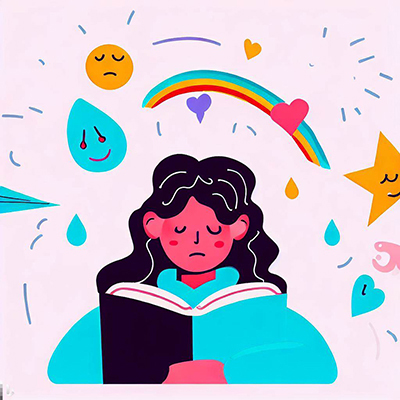Have you ever read a book that made you feel like you were living the story along with the characters? A book that made you think about your own life and how you would handle the challenges they faced?
Novels are powerful. They help us understand ourselves and others better. Reading helps us cope with difficult emotions and situations, such as grief, bullying, and survival, which are common themes in middle grade and young adult books. They are also common experiences in many people's lives. If you haven’t faced some of these issues yourself, you probably know someone who has.
So how can reading novels or writing stories help us deal with these issues? And how can we use these issues to create our own stories? Here are some tips and ideas:
How Stories Help Us Deal with Strong Emotions and Situations

- We feel less alone. When we read about characters who are going through the same things as we are, we relate to them and feel like we have a friend who understands us. We learn from their experiences and see how they cope with their problems.
- Reading helps us process our emotions. When characters are feeling sad, angry, scared, or happy, we can empathize with them and feel those emotions too. This can help us release our own feelings and process them in a healthy way. We can also share the books we like to communicate our feelings to others.
- We find hope and inspiration. When characters overcome their difficulties and achieve their goals, we feel hopeful and motivated. We admire their courage, resilience, and creativity, and try to emulate them in our own lives. And sometimes we find ideas and solutions for our own problems.
How to Use Strong Emotions and Situations to Create Our Own Stories

- We use our own experiences as inspiration. If we have faced an issue in our own lives, we can use those memories as a starting point. We write about how we felt, what we did, and what we learned from those situations. We use our experiences as a springboard for the imagination by changing some details or adding fictional elements.
- We use our imagination to create new scenarios. If we have not faced a scenario the character in our story is facing in our own lives, we can still write about them by using our imagination. We can think of what-if questions, such as "What if I lost my best friend?" or "What if I was stranded on an island?" or "What if I was bullied at school?" We can then imagine how we would react and what would happen next.
- Research—research—research. Whether we use our own experiences or our imagination, research is essential to make our stories more authentic and accurate. Read books and articles about whatever situation has arisen in your story. Talk to people who have gone through those issues or are experts on them. Then use what you’ve learned to drop in a detail here or there which evokes emotions in those who read the story.
Writing novels or stories is challenging but rewarding. Rain Falling on Embers deals with the themes of grief, bullying, survival, and love, to name a few. A challenge to write, but I am so glad I did. It turned out to be a gripping and inspiring story that shows how Katie McCabe overcomes her challenges and grows as a person, finding hope and happiness in her new surroundings.
So next time you read a book, think about how it makes you feel and what you learn from it. And next time you write a story, think about how you can use your experiences, imagination, and research to make it engaging and meaningful.
Happy reading and writing!
This post is part of the Young Writers Series: for more tips, click here.

